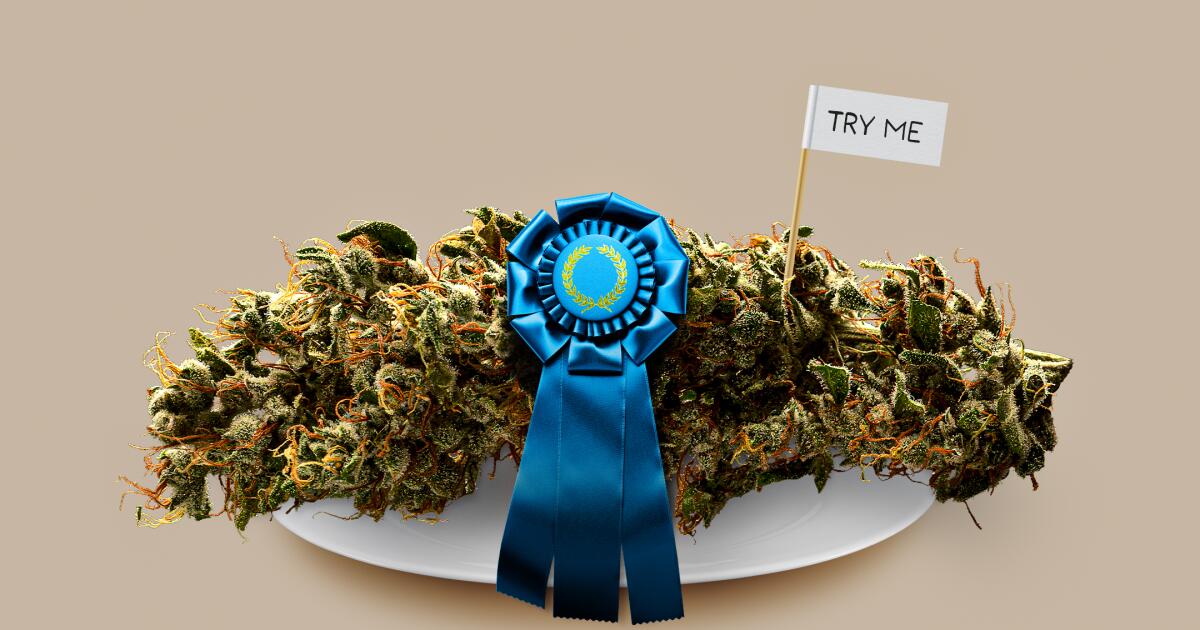Lifestyle
Get high (legally) at the massive new weed oasis inside the California State Fair

For the first time in the 170-year history of the California State Fair, which is scheduled to open July 12 in Sacramento, visitors will be able to do something they haven’t been able to do there before — legally anyway. They will be able to purchase and consume cannabis on-site.
The plans, announced Tuesday by Embarc, the fair’s partner on the project, include having a dispensary and 30,000-square-foot outdoor consumption lounge space at Cal Expo that will allow fair-goers who are 21 and older (and in possession of a valid government-issued photo ID) to buy and try award-winning cannabis.
“When people come to the state fair, they can try the best wine, cheese and craft-brewed beer. That’s already in place,” California State Fair Chief Executive Tom Martinez told The Times. “This was just the natural next step that the legislature and our board of directors is taking.”
The first step came in 2022 when a cannabis exhibit and awards program were added to the fair lineup. It was a chance to showcase the once-demonized plant alongside the rest of the state’s agricultural bounty. “Over the last two years, we’ve had 160,000 people come through that educational exhibit,” Martinez said.
This time around, visitors to the exhibit hall filled with cannabis educational and farm displays will be able to scan QR codes next to displays of this year’s California State Fair Cannabis Award winners and add the goods to an online shopping cart. Then items can be purchased at the checkout at a dispensary just outside. Those who wish to partake can then navigate a few hundred feet farther away and get their smoke on.
Both the dispensary and consumption lounge will be run by Embarc, a Northern California company that’s carved out a niche in the cannabis event space. (The company has organized weed-themed events and spaces for the California Roots Festival and Outside Lands Music Festival, among others).
“‘Designated smoking area’ is the required terminology,” said Embarc’s Chief Executive and co-founder Lauren Carpenter. “But that makes it sound like people standing around outside of a building smoking. This is intended to be experiential and fully built out and produced with a stage where we will have a ceremony for our [cannabis] award winners. [And] right now, our theme is ‘oasis’ — because, in case you missed it, it’s really hot in Sacramento — and our intention is to make this a respite.”
How many visitors to the fair might avail themselves of the 500-person-capacity smoking lounge? “I’m prepared for anything,” Carpenter said. “But based on my back-of-the-napkin math and data from other events we’ve been involved with, we anticipate thousands and thousands of shoppers a day.”
Those thousands and thousands of potential shoppers will be able to shop some 300 different THC-containing products, including many of the 98 freshly crowned winners of 2024 California State Cannabis Awards.
Set to be announced June 26, the 49 silver and 49 gold medals will be awarded in three flower categories (sun-grown, mixed-light and indoor) and 16 product categories (new this year, they include things such as edibles, pre-rolls and concentrates).
In addition, nine “Best of California” Golden Bear awards will be announced at an Oscar-style ceremony scheduled to take place at the fair on July 27.
Know before you go
This year’s California State Fair runs from July 12 to 28. Daily hours for the dispensary and lounge, award winners and additional information will be posted to the 2024 California State Cannabis Awards website at castatefaircannabisawards.com as available.
If you’re planning to get fried in the land of deep-fried everything, there are a few things you’ll need to know: First, you’ll only be able to consume cannabis products purchased on-site. Second, the lounge will provide rolling papers and expects to have an assortment of other smoking paraphernalia to use, so leave your favorite smoking gear at home. And last, while the dispensary and lounge will be open for most of the fair’s run, there are three dates to be aware of: July 12 and 13 (no inhalable consumption will be allowed on those days) and July 19 when the dispensary will be closed.

Lifestyle
It was called the Kennedy Center, but 3 different presidents shaped it

President John F. Kennedy, left, looks at a model of what was later named the Kennedy Center in Washington, DC., in 1963.
National Archives/Getty Images
hide caption
toggle caption
National Archives/Getty Images
On Thursday, the Kennedy Center’s name was changed to The Donald J. Trump and the John F. Kennedy Memorial Center for the Performing Arts.

By Friday morning, workers were already changing signs on the building itself, although some lawmakers said Thursday that the name can’t be changed legally without Congressional approval.
Though the arts venue is now closely associated with President Kennedy, it was three American presidents, including Kennedy, who envisioned a national cultural center – and what it would mean to the United States.

New signage, The Donald J. Trump and The John F. Kennedy Memorial Center for the Performing Arts, is unveiled on Friday in Washington, D.C.
Jacquelyn Martin/AP
hide caption
toggle caption
Jacquelyn Martin/AP
The Eisenhower Administration
In 1955, President Dwight D. Eisenhower first pursued building what he called an “artistic mecca” in Washington, D.C., and created a commission to create what was then known as the National Cultural Center.
Three years later, Congress passed an act to build the new venue with the stated purpose of presenting classical and contemporary music, opera, drama, dance, and poetry from the United States and across the world. Congress also mandated the center to offer public programs, including educational offerings and programs specifically for children and older adults.
The Kennedy Administration
A November 1962 fundraiser for the center during the Kennedy administration featured stars including conductor Leonard Bernstein, comedian Danny Kaye, poet Robert Frost, singers Marian Anderson and Harry Belafonte, ballerina Maria Tallchief, pianist Van Cliburn – and a 7-year-old cellist named Yo-Yo Ma and his sister, 11-year-old pianist Yeou-Cheng Ma.

In his introduction to their performance, Bernstein specifically celebrated the siblings as new immigrants to the United States, whom he hailed as the latest in a long stream of “foreign artists and scientists and thinkers who have come not only to visit us, but often to join us as Americans, to become citizens of what to some has historically been the land of opportunity and to others, the land of freedom.”
At that event, Kennedy said this:
“As a great democratic society, we have a special responsibility to the arts — for art is the great democrat, calling forth creative genius from every sector of society, disregarding race or religion or wealth or color. The mere accumulation of wealth and power is available to the dictator and the democrat alike; what freedom alone can bring is the liberation of the human mind and spirit which finds its greatest flowering in the free society.”
YouTube
Kennedy and his wife Jacqueline were known for championing the arts at the White House. The president understood the free expression of creativity as an essential soft power, especially during the Cold War, as part of a larger race to excellence that encompassed science, technology, and education – particularly in opposition to what was then the Soviet Union.
The arts mecca envisioned by Eisenhower opened in 1971 and was named as a “living memorial” to Kennedy by Congress after his assassination.
The Johnson Administration
Philip Kennicott, the Pulitzer Prize-winning art and architecture critic for The Washington Post, said the ideas behind the Kennedy Center found their fullest expression under Kennedy’s successor, President Lyndon B. Johnson.

“Johnson in the Great Society basically compares the arts to other fundamental needs,” Kennicott said. “He says something like, ‘It shouldn’t be the case that Americans live so far from the hospital. They can’t get the health care they need. And it should be the same way for the arts.’ Kennedy creates the intellectual fervor and idea of the arts as essential to American culture. Johnson then makes it much more about a kind of popular access and participation at all levels.”
Ever since, Kennicott said, the space has existed in a certain tension between being a palace of the arts and a publicly accessible, popular venue. It is a grand structure on the banks of the Potomac River, located at a distance from the city’s center, and decked out in red and gold inside.
At the same time, Kennicott observed: “It’s also open. You can go there without a ticket. You can wander in and hear a free concert. And they have always worked very hard at the Kennedy Center to be sure that there’s a reason for people to think of it as belonging to them collectively, even if they’re not an operagoer or a symphony ticket subscriber.”

The Kennedy Center on the Potomac River in Washington, D.C.
Hulton Archive/Getty Images
hide caption
toggle caption
Hulton Archive/Getty Images
Kennicott estimated it will only take a few years for the controversies around a new name to fade away, if the Trump Kennedy moniker remains.
He likens it to the controversy that once surrounded another public space in Washington, D.C.: the renaming of Washington National Airport to Ronald Reagan Washington National Airport in 1998.

“A lot of people said, ‘I will never call it the Reagan National Airport.’ And there are still people who will only call it National Airport. But pretty much now, decades later, it is Reagan Airport,” Kennicott said.
“People don’t remember the argument. They don’t remember the controversy. They don’t remember the things they didn’t like about Reagan, necessarily. . . . All it takes is about a half a generation for a name to become part of our unthinking, unconscious vocabulary of place.
“And then,” he said, “the work is done.”
This story was edited for broadcast and digital by Jennifer Vanasco. The audio was mixed by Marc Rivers.
Lifestyle
Fashion’s Climate Reckoning Is Just Getting Started

Lifestyle
The 2025 Vibe Scooch

In the 1998 World War II film “Saving Private Ryan,” Tom Hanks played Captain John H. Miller, a citizen-soldier willing to die for his country. In real life, Mr. Hanks spent years championing veterans and raising money for their families. So it was no surprise when West Point announced it would honor him with the Sylvanus Thayer Award, which goes each year to someone embodying the school’s credo, “Duty, Honor, Country.”
Months after the announcement, the award ceremony was canceled. Mr. Hanks, a Democrat who had backed Kamala Harris, has remained silent on the matter. On Truth Social, President Trump did not hold back: “We don’t need destructive, WOKE recipients getting our cherished American awards!!!”
-

 Iowa6 days ago
Iowa6 days agoAddy Brown motivated to step up in Audi Crooks’ absence vs. UNI
-

 Iowa1 week ago
Iowa1 week agoHow much snow did Iowa get? See Iowa’s latest snowfall totals
-

 Maine4 days ago
Maine4 days agoElementary-aged student killed in school bus crash in southern Maine
-

 Maryland6 days ago
Maryland6 days agoFrigid temperatures to start the week in Maryland
-

 Technology1 week ago
Technology1 week agoThe Game Awards are losing their luster
-

 South Dakota6 days ago
South Dakota6 days agoNature: Snow in South Dakota
-

 New Mexico4 days ago
New Mexico4 days agoFamily clarifies why they believe missing New Mexico man is dead
-

 Nebraska1 week ago
Nebraska1 week agoNebraska lands commitment from DL Jayden Travers adding to early Top 5 recruiting class




















